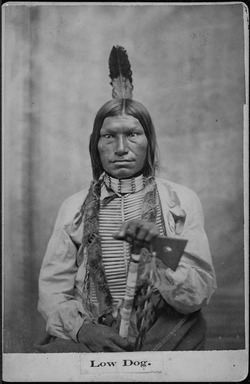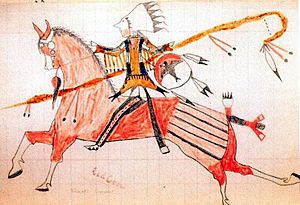Low Dog facts for kids
Quick facts for kids
Low Dog
|
|
|---|---|
|
Šúŋka Khúčiyela
|
|
 |
|
| Oglala Lakota leader | |
| Personal details | |
| Born | c.1846 |
| Died | 1894 |
| Military service | |
| Battles/wars | Little Bighorn |

Low Dog (in Lakota: Šúŋka Khúčiyela) was an important Oglala Lakota chief. He was born around 1846 and passed away in 1894. He is well-known for fighting alongside Sitting Bull at the famous Battle of the Little Bighorn.
Low Dog became a war chief when he was just 14 years old. After the conflicts, he surrendered in 1881. He then lived at the Standing Rock Agency.
Contents
Low Dog's Story of the Little Bighorn
In 1881, Low Dog shared his own account of the Battle of the Little Bighorn. This story was published in a newspaper called the Leavenworth, Kansas Weekly Times. It gives us a special look into the battle from his point of view.
The Battle Begins
Low Dog explained that his people were camped near the Little Bighorn River. They didn't know that white soldiers were coming. An Indian scout, who was looking for lost horses, saw the soldiers first. The soldiers chased him, but he was fast and warned the camp.
Low Dog was sleeping when the alarm sounded. He said it was around noon. At first, he didn't believe it. He thought it was a false alarm because their camp was so strong. Many tribes were there, including the Cheyennes, Arapahoes, and seven different groups of the Teton Sioux. There were countless warriors.
Even though he doubted the alarm, Low Dog quickly got ready. When he came out of his lodge with his gun, the attack had already started. It was happening at the end of the camp where Sitting Bull and the Uncpapas were.
Fighting for Their Families
The Indian warriors held their ground. This gave the women and children time to get to safety. Low Dog ordered his men to get their horses ready. They hurried to help the fighters. Once the women and children were safe, the first group of fighters fell back.
Low Dog's people joined the fight. Other warriors and women helped get horses ready. They pushed the first attacking group back. This group retreated to a high hill. Low Dog warned his men not to chase too far, fearing a trap.
Soon, all the warriors in the camp were on horseback and ready. Then, another group of soldiers attacked from a different side. Low Dog described them as coming "like a thunderbolt." He said he had never seen men so brave and fearless as those white warriors.
A Brave Charge
The Lakota warriors retreated until they were all together. Then, they charged. Low Dog shouted to his men, "This is a good day to die: follow me!" To make sure no one fell back, every warrior whipped another's horse. They rushed right at the soldiers.
As they charged, the white soldiers dismounted to fire. But their shooting was not very good. They held their horses' reins with one arm while shooting. Their frightened horses pulled them around, causing many shots to miss. Low Dog said the white warriors stood their ground bravely. None of them tried to run away. After most of them were defeated, Low Dog captured two of their horses.
After the Fight
Low Dog then went to help fight the other white soldiers. This group had retreated to a high hill on the east side of the river. This was Major Reno's group. Low Dog said he didn't know if any of Custer's soldiers were taken prisoner. When he returned to his camp, all of Custer's men were gone.
The entire fight was very confusing. Low Dog did not see General Custer. He didn't know who defeated him. They didn't even know Custer was the white chief until the battle was over. Low Dog said they had no idea the white soldiers were coming until the scout warned them.
Low Dog respected Reno's fighting. He said Reno fought well. But the Lakota warriors were fighting to protect their women and children. He believed that if Reno's men had fought like Custer's, the battle might have gone differently. Low Dog stated that no white man or Indian ever fought as bravely as Custer and his men.
The next day, they fought Reno's forces again. Many soldiers were lost. Then, the chiefs decided that the soldiers had been punished enough. They chose to be merciful and let them go. They heard another force was coming up the river (General Terry's command). The chiefs decided they had fought enough and should not fight unless attacked. So, they took their families and left.
Low Dog's Reflections
Low Dog's story was told to several army officers. They were very interested and believed his account was true. Someone asked how many Indians were lost in the fight. Low Dog answered, "Thirty-eight, who died then, and a great many — I can't tell the number — who were wounded and died afterwards." He noted that he had never seen a fight where so many were wounded compared to those who died. Many horses were also wounded.
When asked about Sitting Bull's role, Low Dog was not very friendly. He said with a sneer, "If someone would lend him a heart he would fight."
Low Dog was a tall, straight man, about 34 years old at the time. He had regular features and small hands and feet. He explained that when he had his weapons and was on the war-path, he felt no man was better than him. But after surrendering, he put that feeling aside. He said that if anyone tried to mistreat him in his new, humble life, all he could do was tell them they were a coward. This was something he would never have allowed anyone to say to him when he was a warrior.
Becoming a Warrior and a Leader
Low Dog shared his first experience on the war-path when he was 14. He went against his parents' wishes. This happened near the Yellowstone River. They fought against a group of Assiniboins who were hunting buffalo. Low Dog killed one of their men. When another group attacked, he killed another.
When he returned to his tribe, he was made a chief. No Sioux of his age had ever killed two enemies in one fight. He was invited to join the councils of the chiefs and wise men. At that time, they never thought they would fight white people.
Later, he heard that the white chief wanted Indians to live where he ordered and do as he said. He would feed and clothe them. Low Dog was called to a council to discuss this. He wondered why he should let anyone support him against his will, as long as he was strong and able. He didn't think he would ever have to fight white men or follow their orders.
A New Path
As it became clear they would have to either give in or fight, they held many councils. Low Dog asked why he should be kept humble when he was a brave warrior on his own lands. He believed the game, hills, and valleys were his. He felt white men had no right to tell him where to go or what to do. He said if any white man tried to harm his property or take his lands, he would fight them.
He never thought he would change this view. But eventually, he realized that to help his nation, he needed to use wise thinking, not just fighting. He then expressed a desire to learn the white man's ways. He saw that they were stronger and that their government was better.
Quote
"This is a good day to die. Follow me."

